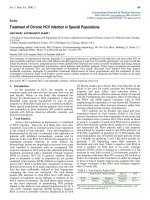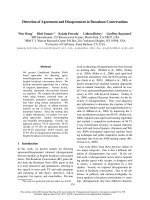Detection of bovine Herpesvirus-1 infection in bovine clinical samples by direct fluorescent antibody test
Bạn đang xem bản rút gọn của tài liệu. Xem và tải ngay bản đầy đủ của tài liệu tại đây (286.85 KB, 6 trang )
Int.J.Curr.Microbiol.App.Sci (2018) 7(11): 2229-2234
International Journal of Current Microbiology and Applied Sciences
ISSN: 2319-7706 Volume 7 Number 11 (2018)
Journal homepage:
Original Research Article
/>
Detection of Bovine Herpesvirus-1 Infection in Bovine Clinical Samples by
Direct Fluorescent Antibody Test
Dharmesh R. Patel*, Irsadullakhan H. Kalyani, Bhavesh J. Trangadia,
Kishan K. Sharma, Pushpa M. Makwana, Dhruv Desai,
Dushyant Muglikar and Pramod S. Sakhare
Department of Veterinary Microbiology, Vanbandhu College of Veterinary Science and
Animal Husbandry, Navsari Agricultural University, Navsari – 396 450, Gujarat, India
*Corresponding author
ABSTRACT
Keywords
BoHV-1, Bovine,
FAT, IBR
Article Info
Accepted:
15 October 2018
Available Online:
10 November 2018
Detection of viral antigen by direct fluorescent antibody test (FAT) from clinical samples
collected from cattle and buffaloes of Navsari, Surat and Valsad Districts of Southern
Gujarat were carried out. Out of a total of 116 clinical samples (44-cattle, 72-buffaloes)
tested, fluorescence was observed in 14 (12.09%) samples. Species-wise, eight cattle
(11.11%) and 6 buffaloes (13.64%) were found to be positive by the test. The highest
number of animals were detected from Surat (14.29%) followed by Valsad (12.07%) and
least in Navsari (10.81%) district. Viral antigen detected in 8.00% (4/50), 7.14% (1/14),
28.57% (2/7) in cattle and 16.67%, (2/12), 16.67% (1/6), 11.547% (3/26) in buffaloes from
nasal, conjunctival and vaginal swabs, respectively. Only placental cotyledon sample
collected from cattle showed positive reaction by direct FAT.
Introduction
Bovine herpesvirus-1 (BoHV-1), a member of
the
subfamily
Alphaherpesvirinae,
is
responsible for causing rhinotracheitis,
pustular vulvovaginitis, abortion, mastitis,
balanoposthitis, infertility, keratoconjunctivitis
and encephalitis in bovines (Gibbs and
Rweyemamu, 1977). In India, the infection
was first reported by Mehrotra et al., (1976)
and since then the disease has been prevalent
and reported by many workers from various
parts of the country (Samal et al., 1981;
Renukaradhya et al., 1996; Trangadia et al.,
2012; Krishnamoorthy et al., 2015). Currently,
virus isolation, ELISA, PCR etc. are used for
the diagnosis of BoHV-1. The present study
was designed to detect BoHV-1 virus in
various clinical samples collected from bovine
of Southern Gujarat by direct fluorescence
antibody test (FAT).
Materials and Methods
Collection of clinical samples
A total of 116 clinical samples comprised of
72 samples (50 nasal swabs, 14 conjunctiva
swabs, 07 vaginal swabs and one placental
cotyledon from aborted case) from cattle and
44 from buffaloes (12 nasal swabs, 06
conjunctiva swabs and 26 vaginal swabs) were
2229
Int.J.Curr.Microbiol.App.Sci (2018) 7(11): 2229-2234
collected from Valsad, Navsari and Surat
districts of Southern Gujarat for detection of
BoHV-1 antigen by direct FAT. These
samples were collected in viral transport
media (VTM) made from Dulbecco’s
modified Eagles media (DMEM) with 2%
foetal calf serum (FCS) with kanamycin from
animals exhibiting clinical signs such as
conjunctivitis,
lacrimation,
serous/
mucopurulant nasal discharge, abortion and
vulvo-vaginitis. Location-wise, species-wise
and breed-wise details of sample collection are
shown in Table 1.
Direct FAT
For standardization of test, infectious bovine
rhinotracheitis (IBR) seed virus was procured
from Veterinary Type Culture Collection
(VTCC), National Research Centre on
Equines (NRCE), Hisar (Haryana) under
Material Transfer Agreement (MTA) and used
as reference virus. Reference virus (100μl)
was inoculated in 25ml tissue culture flask
containing MDBK (Madin Derby Bovine
Kidney) cell monolayer. The flask incubated
at 37ºC for 1 hour and 20ml of DMEM
medium was added to it. Further the flask was
incubated at 37ºC for 24-36 hours till 50%
CPE (Cytopathic Effect) was observed. Then
DMEM medium was discarded and MDBK
cell monolayer was fixed in acetone-methanol
(3:1) solution and further processed as per the
test protocol and reagents supplied by VMRD
Inc., Pullman, WA, USA. In brief, smears
were prepared from 50μl of clinical samples
on clean glass slide. These smears were air
dried overnight at room temperature and fixed
in acetone-methanol (3:1) at room temperature
for 20 minutes. Then the slides were stained
with 50-75μl of direct FA conjugate (Catalog
no.: 210-69-IBR) for 30 min at 37ºC in humid
chamber. Further, the slides were gently rinsed
in FA rinse buffer and soaked for 10 min in
the same buffer. The slides were dried with
paper towel without allowing stained surface
to dry. Slides were mounted with FA
Mounting Fluid and scanned with fluorescent
microscope. Slides showed green fluorescence
were considered as positive (Fig. 1c) While
Figure 1a and 1b indicate the negative and
positive control, respectively.
Results and Discussion
Location-wise, species-wise and breed-wise
incidence of BoHV-1 infection is depicted in
Table 1. The highest incidence recorded in
Surat (14.29%) followed by Valsad (12.07%)
and Navsari (10.81%) with an overall
incidence of 12.09%. Percent positivity in
cattle and buffaloes were 11.11% and 13.64%,
respectively. Comparatively, higher incidence
of BoHV-1 was observed in crossbred cattle
(11.54%) than Gir animals (10.00%), whereas
among buffaloes highest incidence observed
in Mehsani (16.67%) followed by Surti
(14.29%) and Jafarabadi (9.09%) breed.
Sample-wise incidence of BoHV-1 infection is
depicted in Table 2.
Earlier workers (Rissi and Barros; 2013;
Gould et al., 2013) used FAT as a diagnostic
tool for detection of BoHV-1 viral antigen. In
Gujarat, Jain (2006) and Jain et al., (2008)
supported our findings and detected BoHV-1
antigen in 32.67% of semen samples of cattle
and buffaloes by FAT. Further Jain et al.,
(2008b) recorded highest incidence of BoHV1 by direct FAT in Mehsani buffalo bulls
(36.84%) followed by Jafrabadi buffalo bulls
(28.57%) and Surti buffalo bulls (14.28%).
In Odisha, Mishra et al., (1982) found an
incidence of 18% by immunofluorescence
technique. Misra and Mishra (1987) cultured
15 various tissues samples in primary bovine
kidney cells and isolated BoHV-1 from 5
samples and confirmed by direct FAT.
However, Elazhary et al., (1980) demonstrated
BHV-1 in sperm heads from the bull by direct
FAT.
2230
Int.J.Curr.Microbiol.App.Sci (2018) 7(11): 2229-2234
Table.1 Incidence of BoHV-1 antigen in bovine by direct FAT
Attributes
Number tested
A)
Number positive
Percent positive
Location-wise
Valsad
58
07
12.07
Navsari
37
04
10.81
Surat
21
03
14.29
Total
116
14
12.09
B)
Species-wise
Cattle
72
08
11.11
Buffalo
44
06
13.64
Total
116
14
12.09
C)
Breed-wise (Cattle)
Crossbred
52
06
11.54
Gir
20
02
10.00
Total
72
08
11.11
D)
Breed-wise (Buffalo)
Surti
21
03
14.29
Mehsani
12
02
16.67
Jafarabadi
11
01
9.09
Total
44
06
13.64
Table.2 Sample-wise detection of BHV-1 antigen by direct FAT
Sr.
No.
01
02
03
04
Type of
sample
Species of the animals
Total
Cattle
Buffaloes
Tested Positive Tested Positive Tested Positive
Nasal swabs
50
04
12
02
62
06 (9.68)
(8.00)
(16.67)
Conjunctival
14
01
06
01(16.67)
20
02(10.00)
swabs
(7.14)
Vaginal
07
02
26
03
33
05
swab
(28.57)
(11.54)
(15.15)
Placental
01
01(100)
01
01(100)
cotyledons
Total
72
08
44
06
116
14
(11.11)
(13.64)
(12.09)
Note: Figures in parentheses indicate percentage.
2231
Int.J.Curr.Microbiol.App.Sci (2018) 7(11): 2229-2234
Fig.1a Normal uninfected MDBK cell monolayer as negative control at 36 hrs stained with
direct FA conjugate viewed under fluorescent light microscope (100X)
Note: The absence of fluorescence
Fig.1b BoHV-1 reference virus infected MDBK cell monolayer as positive control after 36 hrs
stained with direct FA conjugate viewed under fluorescent light microscope (400X)
Note: The presence of fluorescence at the place previously CPE observed
2232
Int.J.Curr.Microbiol.App.Sci (2018) 7(11): 2229-2234
Fig.1c Immunofluorescent staining reaction with free BoHV-1 antigen cluster and direct FA
conjugate in smear prepared from clinical sample
Note: The brightly fluorescing cluster of BoHV-1 (400X)
Due to the lack of published literature on
detection of BHV-1 infection in semen
samples using direct FAT, it is difficult to
compare this study and to reach meaningful
conclusions. However, it is deduced that the
direct FAT can be a valuable test for detection
of BoHV-1 antigen within a short period of
time. Considering the fact that BoHV-1 can
be transmitted through various routes, the
findings of this study should be taken as an
indicator of evidence of infection in the South
Gujarat region of Gujarat. It warrants large
scale systemic surveillance using appropriate
sampling techniques to assist in planning of
state level disease control programme.
Acknowledgement
The authors are thankful to Dr. N.H.
Kelawala, the Dean, Navsari Veterinary
College for providing all necessary facilities
to conduct this study. Authors are also
grateful to Dr. Navin Kumar, VTCC, NRCE,
Hisar, Haryana for timely supply of BoHV-1
reference virus strain under MTA. Thanks are
also due to NCCS, Pune, Maharashtra for
supplying MDBK cell line. Authors are also
thankful to the In-charge / veterinarians of
veterinary
dispensary,
college
clinic,
panjarapoles and clinical camps of Surat,
Navsari and Valsad districts for extending
their help during sample collection.
References
Elazhary, M. A. S. Y., Lamothe, P., Silim, A.
and Roy, R. S. 1980. Bovine
herpesvirus type 1 in the sperm of a bull
from a herd with fertility problems.
Canadian Veterinary Journal. 21: 336339.
Gibbs and Rweyemamu (1977). Bovine
herpesviruses. Part I, Commonwealth
Bureau of Animal Health. Vet. Bull. 47:
317-343.
Gould, S., Cooper, V. L., Reichardt, N. and
O’ Connor, A. M. 2013. An evaluation
of the prevalence of Bovine herpesvirus
1 abortions based on diagnostic
submissions
to
five
U.S.-based
veterinary
diagnostic
laboratories.
2233
Int.J.Curr.Microbiol.App.Sci (2018) 7(11): 2229-2234
Journal of Veterinary Diagnostic
Investigation 25: 243-247.
Jain, L. 2006. Detection of Bovine
herpesvirus 1 (BHV-1) infection in
breeding bulls by serological and
molecular
methods
and
its
characterization by sequencing of PCR
products. M.V.Sc. thesis submitted to
A.A.U, Anand.
Jain, L., Kanani, A.N., Patel, T.J., Purohit,
J.H., Jhala, M.K., Joshi, C.G., Chandel,
B.S. and Chauhan, H.C. 2008.
Detection of Bovine herpesvirus 1
(BHV-1) infection in semen of breeding
bulls of Gujarat by A direct
fluorescence. Buffalo Bulletin 27: 202206.
Krishnamoorthy, P., Patil, S. S., Shome R.
and Rahman, H. 2015. Seroepidemiology of infectious bovine
rhinotracheitis and brucellosis in
organized dairy farms in southern India.
Indian Journal of Animal Sciences 85:
695-700.
Mehrotra, M. L., Rajya, B. S. and Kumar, S.
1976. Infectious bovine rhinotracheitis
(IBR) keratoconjunctivities in calves.
Indian J. Vet. Path. 1: 70-73.
Mishra, P. K., Mishra, A., Tripathy, S. B.,
Parhi, N. K. and Nayak, B. C. 1982.
Detection
of
infectious
bovine
rhinotracheitis (IBR) virus in semen by
immunofluorescence technique. Indian
J. of Vet. Med. 2: 62-64.
Misra, P. K. and Mishra, A. 1987. Infectious
bovine rhinotracheitis virus infection
and infertility in cows, heifers and bulls.
SO: Indian Journal of Animal Sciences.
57: 267-271.
Renukaradhya, G. J., Rajasekhar, M. and
Raghavan, R. 1996. Prevalence of
infectious bovine rhinotracheitis in
Southern India. Rev. Sci. Tech. Off. Int.
Epiz. 15: 1021-1028.
Rissi, D. R. and Barros, C. S. L. 2013.
Necrotizing meningoencephalitis in a
cow. Veterinary Pathology 50: 926-929.
Samal, S. K., Mallick, B. B. and Das, S. K.
1981. Note on the incidence of IBR
virus infection among cattle in India.
Indian J. Anim. Sci. 51: 895-897.
Trangadia, B.J., Rana, S.K., Nagmani, K. and
Srinivasan, V.A. 2012. Serological
Investigation of Bovine Brucellosis,
Johne’s Disease and Infectious Bovine
Rhinotracheitis in Two States of India.
Journal of Advanced Veterinary
Research, 2: 38-41.
How to cite this article:
Dharmesh R. Patel, Irsadullakhan H. Kalyani, Bhavesh J. Trangadia, Kishan K. Sharma,
Pushpa M. Makwana, Dhruv Desai, Dushyant Muglikar and Pramod S. Sakhare. 2018.
Detection of Bovine Herpesvirus-1 Infection in Bovine Clinical Samples by Direct Fluorescent
Antibody Test. Int.J.Curr.Microbiol.App.Sci. 7(11): 2229-2234.
doi: />
2234









